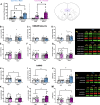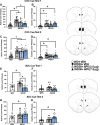This is a preprint.
Inactivation of NMDAR and CaMKII signaling within the prelimbic cortex blocks incubated cocaine- and sucrose-craving
- PMID: 40791399
- PMCID: PMC12338574
- DOI: 10.1101/2025.07.10.664193
Inactivation of NMDAR and CaMKII signaling within the prelimbic cortex blocks incubated cocaine- and sucrose-craving
Abstract
The incubation of craving is a term coined to characterize the behavioral phenomenon wherein cue-elicited craving strengthens over a period of abstinence. Incubated cocaine-craving is mediated, at least in part, by increased glutamate release within the prelimbic cortex (PL). We hypothesized that this glutamate release stimulates NMDA-type glutamate receptors (NMDARs) leading to calcium-dependent activation of CaMKII signaling that drives incubated craving. To test this hypothesis, adult male and female Sprague-Dawley rats were trained to self-administer either IV cocaine or sucrose pellets (6h/day x10 days) and tested for cue-elicited cocaine- or sucrose-craving in early versus later (i.e. after incubation) withdrawal. Incubated cocaine-seeking was associated with increased CaMKII activity in the PL, but no change in NMDAR subunits. In contrast, incubated sucrose-craving was associated with many sex-dependent changes in both NMDAR subunit expression and CaMKII activation that were subregion-selective. An intra-PL infusion of the NMDA antagonist D-AP5 (2.5 or 7.5 μg/side) or the CaMKII inhibitor myr-AIP (10 pg/side) blocked both incubated cocaine- and sucrose-craving, with no effects detected in early withdrawal. Co-infusion of both D-AP5 and myr-AIP exerted an additive effect on incubated cocaine-craving that was larger than either antagonist alone. These data corroborate earlier evidence for distinct biochemical correlates within mPFC between incubated cocaine- and sucrose-craving and, for the first time, demonstrate that NMDARs and CaMKII activation within the PL are common drivers of incubated craving that operate via independent signaling pathways suggesting combined pharmacological treatments may have greater efficacy in managing addiction.
Keywords: NMDA receptor; calcium/calmodulin-dependent kinase; incubation of craving; prefrontal cortex; sex differences.
Figures





References
-
- Centers for Disease Control and Prevention. (2023, August 23). Stimulant overdose. Centers for Disease Control and Prevention.
-
- Gawin F.H., Kleber H.D. (1986) Abstinence symptomatology and psychiatric diagnosis in cocaine abusers. Clinical observations. Arch Gen Psychiatry, 43, 107–113. - PubMed
Publication types
Grants and funding
LinkOut - more resources
Full Text Sources
Miscellaneous
